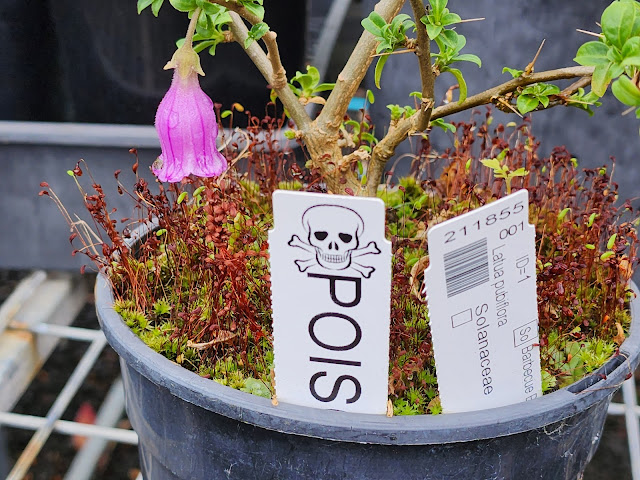Happy plant with mostly unhappy consequences
Behold the purple bell-flowers of the Tree of Wizards, a plant for sorcerers and shamans perhaps but to handle with extreme care. All parts of the plant are 'extremely poisonous' and even within our protected nursery at Royal Botanic Gardens Melbourne we label the plant as one to avoid touching.
As with so many potent plants, Latua pubiflora, is in the family Solanaceae, nestled alongside mandrake and deadly nightshade, but also the edible 'toes' (toma- and pota-). The genus name, Latua, is from the Mapuche word latúe, meaning 'that which causes death'. In Chile, it's said, the toxicity of the plant is such that people avoid even mentioning it.
There is only one species of Latua, Latua pubiflora, named fairly obviously after the fine hairs that cover the outside of its hummingbird pollinated flowers. Flowers photographed here (without hummingbirds) in February this year. They are just one of the attractive characteristics of this species, which according to some is made even more beautiful - due to larger leaves - when grown in shade.
In nature plants can be thorned or thornless, and these two variations are sometimes treated as separate varieties. As you can see, our plants are thorny. The leaves are not particularly large, suggesting our shade is not particularly shady.
In Chile, the fruits are small, yellow-green, tomato-like berries, and full of seeds. I don't think our plants set fruit or seed, possibly due to the paucity of hummingbirds in our shade-house.
I'm not going to document or debate the medicinal or recreational use of the plant, except to repeat the fact that it is extremely poisonous. From the size of the entry for this species in Wikipedia, I can assume there is plenty of interest and perhaps intrigue in the plant.
From that extended essay I discovered that the flower colour is best described as magenta, even though sometimes described as red or violet (or here, as purple). I also discovered that while it was originally a plant of rainforests, it has readily adapted to land clearing and now survives, and perhaps thrives, on cultivated farmland. All within a narrow latitude range in the mountains of southern Chile.
Given it almost weediness between 40 and 43 degrees south in South America, it might be happy in Tasmania or the South Island of New Zealand. In a pot, in a shade-house, and cared for by our expert nursery staff at Royal Botanic Gardens Victoria, it also seems rather content.




Comments